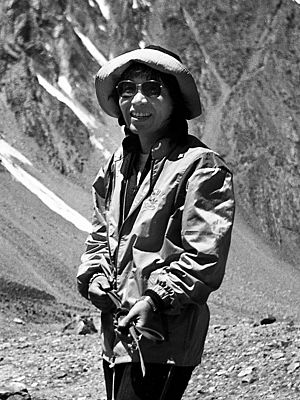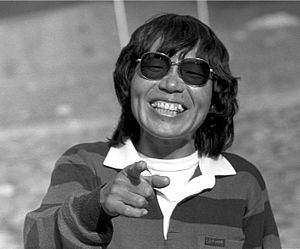Junko Tabei facts for kids
Quick facts for kids
Junko Tabei
|
|
|---|---|
| 田部井 淳子 | |

Junko Tabei in 1985 at Communism Peak
|
|
| Born |
Junko Ishibashi
22 September 1939 Miharu, Empire of Japan
|
| Died | 20 October 2016 (aged 77) Kawagoe, Japan
|
| Nationality | Japanese |
| Occupation | Mountaineer, author, teacher |
| Known for | First woman to summit Mount Everest (1975); first woman to ascend the Seven Summits (1992) |
| Spouse(s) | Masanobu Tabei |
| Children | 2 |
Junko Tabei (born Junko Ishibashi; 22 September 1939 – 20 October 2016) was a Japanese mountaineer, author, and teacher. She made history as the first woman to reach the top of Mount Everest. She was also the first woman to climb the Seven Summits. This means she climbed the highest mountain on each of the seven continents.
Junko Tabei wrote seven books. She also worked on projects to clean up trash left by climbers on Everest. After the Great East Japan Earthquake, she led yearly climbs up Mount Fuji for young people affected by the disaster.
An asteroid was named 6897 Tabei in her honor. In 2019, a mountain range on Pluto was also named Tabei Montes to remember her amazing achievements.
Contents
Early Life and First Climbs
Junko Ishibashi was born on September 22, 1939. She was the fifth of seven children. Her father worked as a printer. Junko was a small child, but she started mountain climbing at age ten. Her first trip was a school climb to Mount Nasu.
She loved how climbing was not about competing with others. She also enjoyed the beautiful views from the top of the mountains. Her family did not have much money for this hobby. So, Junko only went on a few climbs during her high school years.
From 1958 to 1962, Junko studied English and American literature at Showa Women's University. She first planned to become a teacher. After college, she went back to her love for climbing. She joined several climbing clubs that were mostly for men. Some men welcomed her, but others wondered why a woman wanted to do a sport usually done by men. Soon, Junko had climbed all the main mountains in Japan, including Mount Fuji.
When she was 27, Junko married Masanobu Tabei. He was also a mountaineer whom she met on a climbing trip. They later had two children, a daughter named Noriko and a son named Shinya.
Climbing Adventures
Starting a Women's Climbing Club
In 1969, Junko Tabei started the Joshi-Tohan Club. This was a climbing club just for women. Their motto was "Let's go on an overseas expedition by ourselves." It was the first club of its kind in Japan. Junko said she started the club because of how some male climbers treated her. Some men refused to climb with her. Others thought she only wanted to find a husband through climbing. To help pay for her climbing, Junko worked as an editor for a science journal.
The Joshi-Tohan Club went on their first big trip in 1970. They climbed Annapurna III in Nepal. They reached the top using a new path on the south side. This was the first time women and Japanese climbers had reached that summit. Junko and another member, Hiroko Hirakawa, were chosen for the final climb. Two sherpa guides went with them. It was so cold that their camera film broke.
Junko learned from this trip that Japanese women sometimes found it hard to show they needed help. They were used to being quiet and strong. But mountain climbing made them realize they had limits. It taught them to accept help from each other.
The 1975 Everest Expedition
After climbing Annapurna III, the Joshi-Tohan Club decided to try Mount Everest. They formed a team called the Japanese Women's Everest Expedition (JWEE). Eiko Hisano led the team. The JWEE had 15 members. Most were working women from different jobs. Two of the women, including Junko, were mothers. They asked for permission to climb Everest in 1971. They had to wait four years to get a spot on the climbing schedule.
Junko helped find sponsors for the trip. But people often told her that women "should be raising children instead." She finally got money from a newspaper and a TV station. Still, each team member had to pay a lot of money. Junko gave piano lessons to earn her share. To save money, she made much of her own gear. She made waterproof gloves from her car cover. She sewed climbing pants from old curtains.
After a long time of training, the team started their climb in May 1975. Many reporters and a TV crew followed them at first. They used the same path that Sir Edmund Hillary and Tenzing Norgay used in 1953. Six sherpa guides helped the team throughout the trip.
On May 4, an avalanche hit their camp. It was at about 20,700 feet (6,300 meters). Junko and four other climbers were buried under the snow. Junko passed out until the sherpa guides dug her out. Luckily, no one died. Junko was bruised and hurt. She could barely walk and had to rest for two days. But as soon as she could, she continued the climb.
The team had planned for two women to reach the peak. But one of the sherpas got altitude sickness. This meant they could not carry enough oxygen for two climbers. Only one woman could go on. After much talk, Hisano chose Junko to finish the climb.
Near the top, Junko was angry to find a thin, dangerous ice ridge. No one had mentioned it in earlier climbing stories. She crawled sideways across it. She later said it was the most stressful thing she had ever done. Twelve days after the avalanche, on May 16, 1975, Junko Tabei became the first woman to reach the summit of Everest. Her sherpa guide, Ang Tsering, was with her.
Junko received a lot of attention for her achievement. There was a parade for her in Kathmandu. When she returned to Japan, thousands of cheering fans met her at the airport. She got messages from the King of Nepal and the Japanese government. A TV show was made about the Everest trip. Junko also made many public appearances across Japan. However, she did not like being so famous. She later said she preferred to be remembered as the 36th person to climb Everest. "I did not intend to be the first woman on Everest," she said.
Later Adventures and Environmental Work

Junko Tabei kept climbing mountains. She eventually climbed the highest mountain on each continent. These included Kilimanjaro (1980), Mt. Aconcagua (1987), Denali (1988), Mt. Elbrus (1989), Mount Vinson (1991), and Puncak Jaya (1992). When she climbed Puncak Jaya, she became the first woman to complete the Seven Summits challenge. By 2005, Junko had been on 44 all-female climbing trips around the world. She had a personal goal to climb the highest mountain in every country. By the end of her life, she had climbed at least 70 of these mountains.
After Mount Everest, she never accepted money from big companies. She wanted to stay financially free. She earned money for her trips by giving talks, leading climbing tours, and teaching music and English to children. Sometimes, her friends and supporters also gave her food and equipment.
Besides climbing, Junko Tabei cared about the environment. In 2000, she studied at Kyushu University. Her studies focused on how trash left by climbing groups was harming Everest. Junko was also a director for the Himalayan Adventure Trust of Japan. This group works to protect mountain environments worldwide. One of their projects was to build a special burner to get rid of climbers' trash. She also led and joined "clean-up" climbs in Japan and the Himalayas with her husband and children.
In May 2003, a celebration was held in Kathmandu. It marked 50 years since the first successful climb of Mount Everest. Many Nepalese people cheered a parade of past Everest climbers. Junko Tabei and Sir Edmund Hillary were given a special place in the celebration for their achievements.
Between 1996 and 2008, Junko wrote seven books. After the Great East Japan Earthquake in 2011, Junko started organizing yearly trips up Mount Fuji. These trips were for schoolchildren affected by the disaster.
Death and Legacy
Junko Tabei was diagnosed with stomach cancer in 2012. But she kept climbing and doing many of her activities. In July 2016, even though she was very sick, she led a youth trip up Mount Fuji. She died in a hospital in Kawagoe on October 20, 2016.
Before Junko's death, an astronomer named asteroid 6897 Tabei after her.
On September 22, 2019, Google honored her 80th birthday with a special Doodle. It shared her inspiring motto: "Do not give up. Keep on your quest."
On November 19, 2019, a mountain range on Pluto was named Tabei Montes. This was to honor Junko's amazing climbing achievements. Mountains on Pluto are named after "Historic pioneers who crossed new horizons in the exploration of the Earth, sea and sky."
See also
 In Spanish: Junko Tabei para niños
In Spanish: Junko Tabei para niños
- List of 20th-century summiters of Mount Everest
- List of climbers and mountaineers
- List of female explorers and travelers
- List of Mount Everest records
- List of women's firsts
- Timeline of Mount Everest expeditions




